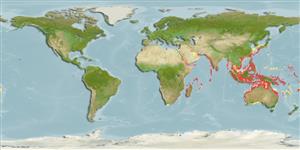Environment: milieu / Klimaatzone / Diepte / distribution range
Ecologie
marien; brak water rifbewoner; diepte 1 - 50 m (Ref. 90102). Tropical
Indo-Pacific: Red Sea (Ref. 33390) and East Africa to Papua New Guinea (Ref. 9710), north to southern Japan, south to Australia.
Grootte / Gewicht / Leeftijd
Maturiteit: Lm ? range ? - ? cm
Max length : 300 cm TL mannelijk / geslacht onbekend; (Ref. 9710)
Dorsale stekels (totaal) : 0; Dorsale zachte stralen (totaal) : 0; Anale stekels: 0; Anale zachte stralen: 0; Wervels: 138 - 144. Basically white with black blotches and interspaces forming a honeycomb pattern (Ref. 30404, 48635). Some individuals have a near black overall appearance (Ref. 48635). Blotches variable between individuals and size, often in relation to habitat - those in clear coral reefs usually have proportionally less black than those found in turbid waters (Ref. 30404).
Body shape (shape guide): eel-like; Cross section: compressed.
Inhabits reef flats and outer reef slopes of continental reefs (Ref. 9710). One of the two largest of Indo-Pacific morays. Often in holes with cleaner wrasses or shrimps (Ref. 48635). Feeds on cephalopods and small fishes (Ref. 30573). Large adults may be aggressive (Ref. 9710). Minimum depth reported taken from Ref. 30573.
Levenscyclus en paargedrag
Maturiteit | Voortplanting | Paaien | Eieren | Fecunditeit | Larven
Chen, H.-M., K.-T. Shao and C.T. Chen, 1994. A review of the muraenid eels (Family Muraenidae) from Taiwan with descriptions of twelve new records. Zool. Stud. 33(1):44-64. (Ref. 6934)
Status op de Rode Lijst van het IUCN (Ref. 130435: Version 2025-1)
Gevaar voor de mens
Reports of ciguatera poisoning (Ref. 4537)
Gebruik door de mens
Visserij: van minder commercieel belang; Aquarium: Publieke aquaria
Tools
Speciale rapporten
Download XML
Internetbronnen
Estimates based on models
Preferred temperature (Ref.
123201): 24.5 - 29.1, mean 28.1 °C (based on 1258 cells).
Fylogenetische diversiteitsindex (Ref.
82804): PD
50 = 0.5000 [Uniqueness, from 0.5 = low to 2.0 = high].
Bayesian length-weight: a=0.00035 (0.00021 - 0.00058), b=3.27 (3.13 - 3.41), in cm total length, based on LWR estimates for this species & Genus-body shape (Ref.
93245).
Trofisch niveau (Ref.
69278): 4.4 ±0.51 se; based on food items.
Weerstandsvermogen (Ref.
120179): Zeer laag, minimale populatieverdubbelingstijd meer dan 14 jaar (Preliminary K or Fecundity.).
Fishing Vulnerability (Ref.
59153): Very high vulnerability (90 of 100).
🛈
Nutrients (Ref.
124155): Calcium = 13.2 [6.2, 23.6] mg/100g; Iron = 0.323 [0.176, 0.697] mg/100g; Protein = 19.2 [16.9, 21.8] %; Omega3 = 0.0899 [, ] g/100g; Selenium = 59.6 [27.8, 126.1] μg/100g; VitaminA = 33.6 [8.2, 149.0] μg/100g; Zinc = 0.836 [0.553, 1.234] mg/100g (wet weight);
